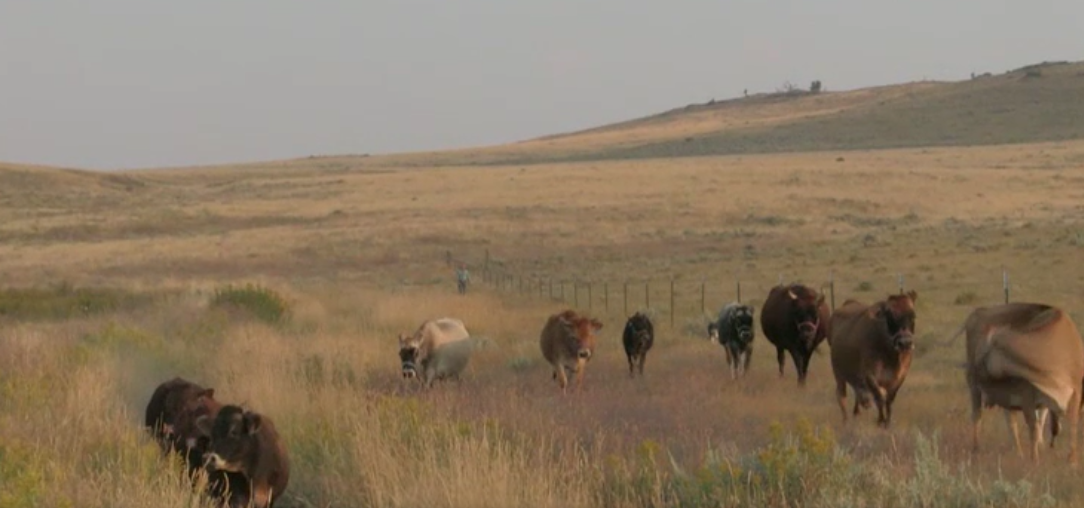
Part Three:
Holding Ground
What does it take to raise beef on the edge of American agriculture?
At the edge of rancher Jenny Sabo’s property on the plains below the Tobacco Root Mountains of Montana, there is still an artifact of one generation’s lost struggle with the soil of this unforgiving landscape. More than a century ago, at the urging of the United States government, tens of thousands of people, some of them immigrants, started new lives and often new careers as farmers, lured by a chance at quick money in farming. As the best-endowed lands at the heart of the continent became overcrowded, the US government began selling swathes of Montana for practically nothing, on the condition that farmers made “improvements,” like turning native grasslands over to grain.
On what is now the Sabos’ property, some of those farmers built a school, homes, and a barn to keep their wheat. The government offered 160 acre plots, assuming a plot that size could work in Montana just as it worked for farmers in Iowa or Minnesota, where agriculture thrived. But the growing season here was short, the rainfall was weak and infrequent, the winters were long. Worst of all, the soil was thin, and infertile, not like the rich, black layers of the Midwest, where just about anything could grow. In the soil here, American agriculture found a limit, and in plowing it up, the farmers ran up against it— fast. From 1919-1925, about two million acres— about a fifth of the state’s farmland—became so denuded of soil it had to be abandoned.
“These are very fragile soils here,” Jenny says near the remains of one of these settlements. Kneeling to the ground, she scoops the top of a rodent hole and watches it blow out of her hand.
“If you disturb the surface of this soil more than just a gopher hole someplace, and you plow it up, it’s hard to get it back, to get the soil biology going again,” she says. The error people make here is not to farm carelessly, Jenny says. The mistake is to farm it at all. “These grasslands need to stay grasslands,” she says.
Stretched between the Rocky Mountains and the northern plains of the United States, Montana is on the figurative and geographic periphery of the American agricultural heartland. In 2014, US agriculture earned $91 billion in profit. Despite having more than six percent of the farmland in the United States, less than one percent of those earnings came from here. In the parlance of agriculture, the whole state is “marginal land.” Jenny goes even further. She calls it a desert.
Beef is the biggest earner in Montana. But with so little fertility here, the ranchers who endure have done so not by exploiting natural processes but by adapting to them, feeding animals with the vegetation that thrives here—grass—which can then feed people with their meat. Soil is a finite, fragile resource everywhere in the world, but here, farmers and ranchers who don’t treat it that way risk losing the ground from under their feet.
“A lot of ranchers in this state will tell you they’re grass farmers,” says Dr. Patrick Hatfield, a specialist in using animals in sustainable agriculture systems at Montana State University in Bozeman. “It is the most abundant carbohydrate on dry land, and ruminants like sheep and cattle can use it. It’s a great avenue to take advantage of sunlight, turn it into grass, and turn it into high-quality protein.”
That’s a contrast to the way most cattle feed is produced in the United States. Since chemical fertilizers, herbicides, and pesticides became widely available in the 1970s, making it easy to suppress weeds and add fertility to soil, Midwestern farmland has been widely turned over to two commodity crops: corn and soybeans. Growing a single crop year after year, and leaving the ground bare between harvests, exerts enormous pressure on soil. Exposed to the elements over a long winter, soil is prone to dry come spring, and as soil dries, it washes away in the rain, or blows away in the wind. In the state of Iowa, over-fertilization, monocropping, and plowing have caused so much erosion the state now has half the topsoil it did a century-and-a-half ago, with much of the washed away soil disappearing into the Mississippi River and flowing into the Gulf of Mexico. That Iowa can keep growing after losing so much of its soil is mostly a testament to how much topsoil the state had to begin with.
But this kind of farming, called monoculture, has economic advantages. In the United States, the government will pay a farmer for the soy and corn he or she produces. Large grain buyers like Archer Daniels Midland and Cargill—always hungry for fodder to feed the meat and ethanol industries—offer an easy path to market. If a crop fails, the government offers insurance.
CROP PLANTINGS IN THE UNITED STATES, 2014

DOTS REPRESENT PLANTINGS OF VARIOUS CROPS IN 2014. SOURCE: US DEPARTMENT OF AGRICULTURE'S CROPSCAPE
As farming has become more difficult in the United States, farmers have come to rely more on these guarantees. The result, displayed in the above map from the US Department of Agriculture's CropScape system, has been an abundance of cheap corn and soy, with a lot of both going to feed chickens, pigs, and beef steers to make American meat artificially cheap. In 2014, 44 percent of the more than 360 million metric tons of corn consumed in the United States was used for animal feed. Another 44 percent was used for ethanol, leaving less than 12 percent to be consumed by humans directly. It’s a similar story for soybean meal: out of 39 million metric tons, 98 percent was used for feed.
Despite the orientation to grain, Montana ranchers have found a niche in the beef industry raising cows to an early age and then selling them to Midwestern feedlots to be fed grain for the last months of their lives before slaughter. Some ranchers go further, raising their cows to the end, or “finishing” their cows on grass. Finishing with grass is tedious and expensive, and after decades of eating the meat of cows finished on grain, consumers accustomed to American beef—both domestic and global—prefer the corn-fed stuff to beef from a cow that ate grass its entire life. For all those reasons, ranchers who finish on grass are a rare breed, anywhere in the United States.
Even by Montana standards, Jenny may be obsessive about her soil. For her, taking the approach of “sustainable agriculture” is not only a matter of avoiding the chemical fertilizers, herbicides, and pesticides that so much of the developed world’s food supply relies on today. Rather, it in involves the endless application of small solutions to small problems, all intended to grow food without doing harm to the land.
SABO RANCH
FILMED BY ALEX PARK. EDITED BY PIERRE KATTAR.
Jenny grew up in a suburb of Columbus, Ohio, in the American Midwest. She came to Montana at the age of 35, following the example of her brother, another rancher in the area, like him, setting out to grow food using only a minimum of chemicals on the soil. Doing otherwise, Jenny says, would be not just a disservice to the soil, but, to the food that grows out of it, and, ultimately, everyone who eats it.
When they bought their current ranch, Jenny and her husband, Mark, wanted to devote themselves completely to the soil without having to mind cattle of their own. It was a simple arrangement: the Sabos cared for the land, and the neighbors let their cows graze on it.
But then Jenny learned that a common medication the other ranchers used to kill worms in their cows’ guts also killed earthworms in the ground. It was a similar problem with antibiotics, which cow guts absorb poorly, and pass unharmed onto soil through manure.
“We said, ‘ah, all our neighbors are using that wormer, all those cows are pooping that wormer-filled manure onto our land, and I think we probably want to get rid of that to start moving to the next soil-health step up,’” Jenny says.
Today, more than a hundred cattle live and graze on the Sabos’ 6,500-acre property, and on an additional 1,240 acres of adjacent land which the Sabos lease every year from the state of Montana. The beef steers eat the sweetest ends of the grass and fertilize the land with their manure before wandering to another part of the ranch to repeat the process while the chewed down part of the ranch they left grows back. In the winter, when the grasses are nutrient weak, the cows eat the hay grass harvested from the previous year. The animals’ feed grows where they live, or nearby. There are no imports of lime, no fertilizers except the cows’ manure. Fertility is not a chemical to be added but a quality inherent to the soil, passed through the cows and returned to the land. The ranch feeds 40-60 families, year round. It may not produce a lot, but it can last.
But while the logic of it is simple, the process rarely is. All these practices take knowledge that is not easily found. When she first started farming, Jenny’s main sources of information were trade magazines which promote low-chemical agriculture like Acres U.S.A. and The Stockman Grass Farmer. The local university, she says, was of little help.
“The return to non-chemical agriculture has been pretty new in this country,” Jenny says. “It takes a lot of expertise, a lot of mistakes to do well… We were the crazy people down the road for the last fifteen years because no one else was doing this. In fact, no one else still is doing this, so we don’t have a community of support that’s right around us, and we have to build our community.”
To build that community, Jenny has developed a network outside her geography. In 2004, she started a Yahoo group with two other women called “Women of the Dirt” to swap advice. Membership has since swelled to more than 250, and growing. As one of the older hands in the group, Jenny is one of the people dolling advice to newcomers many of whom, like her, have abandoned lives and offices in the suburbs for a life on a farm. The members teach each other, sometimes pulling how-to guides from magazines from another era. For instructions on how to build a worm colony out of cow manure, Jenny pulled an article from a magazine from 1888.
“The first thing any of us can do is to recognize that we as consumers are very powerful, and if we are not farming ourselves… there are farmers markets in every town in the country, and there are local farmers in every county across the entire world,” Jenny says. “Every time we support someone who… is happy to let you walk on their farm, who is proud of their soil management practices, every time we purchase something from one of those farmers, we vote with our feet, and with our mouths, and with our wallets for good soils.”
See the next parts in this series:
The Ecology of Knowledge
How do farmers learn to be soil stewards? We asked some from all over the world.
Common Ground
What can Cuba teach the world about preserving its soil?
Did you miss a part of the series?
From the Ground Up
Though we don’t think about it, soil is a finite resource — a living ecosystem that’s way more complex, important and fragile than you think.
Where the Grass is Greener
A global soy boom has turned Brazil's grasslands into a farm. Now the farm is under threat.
See our latest and greatest. Follow us on Facebook and Twitter.

